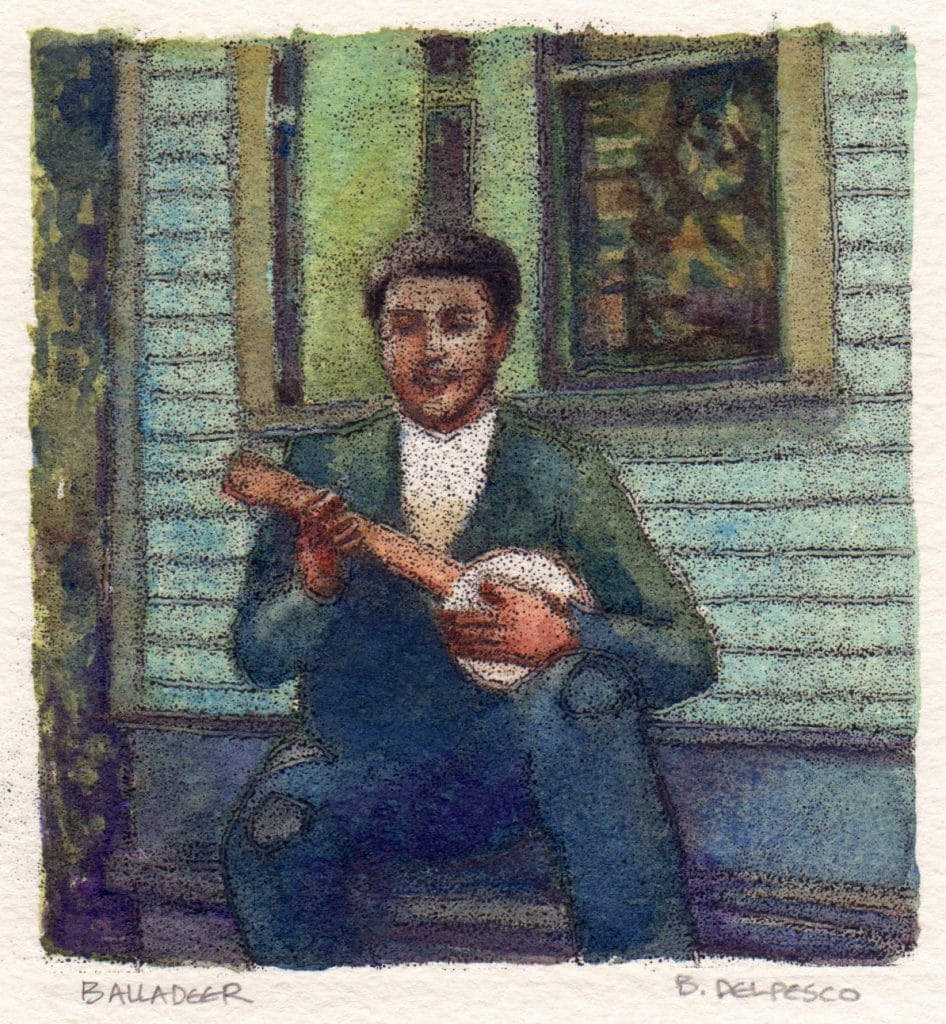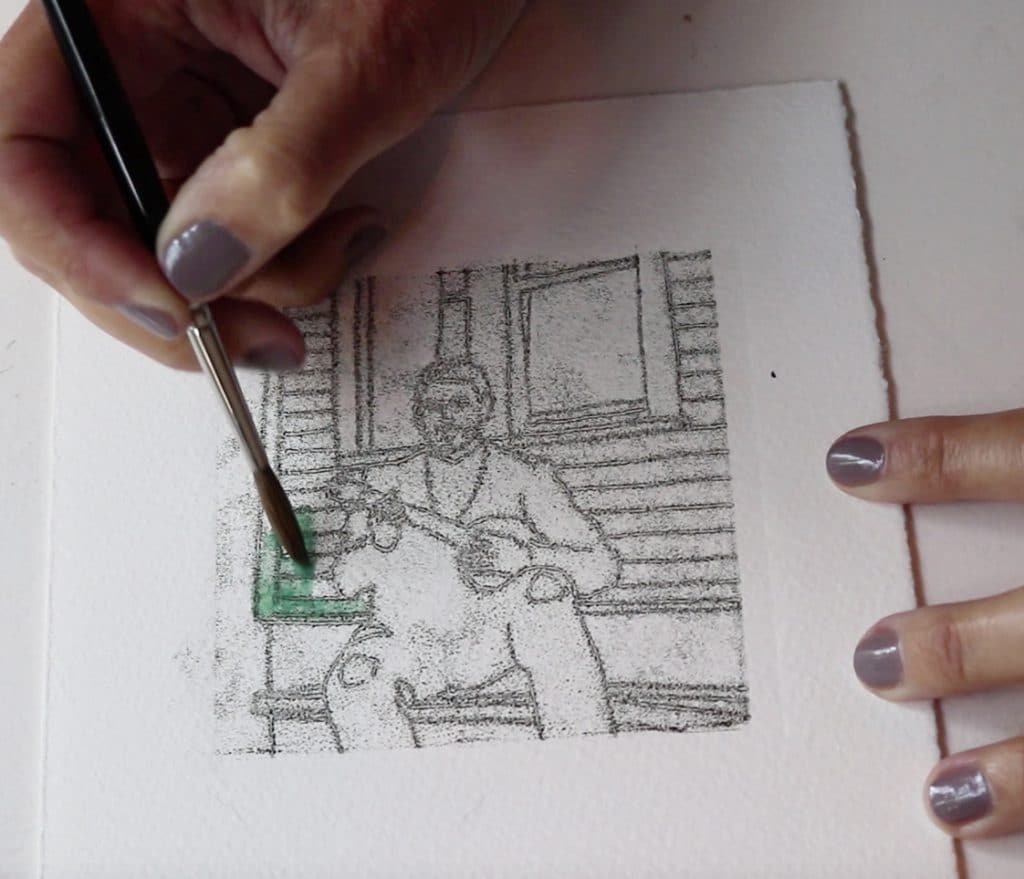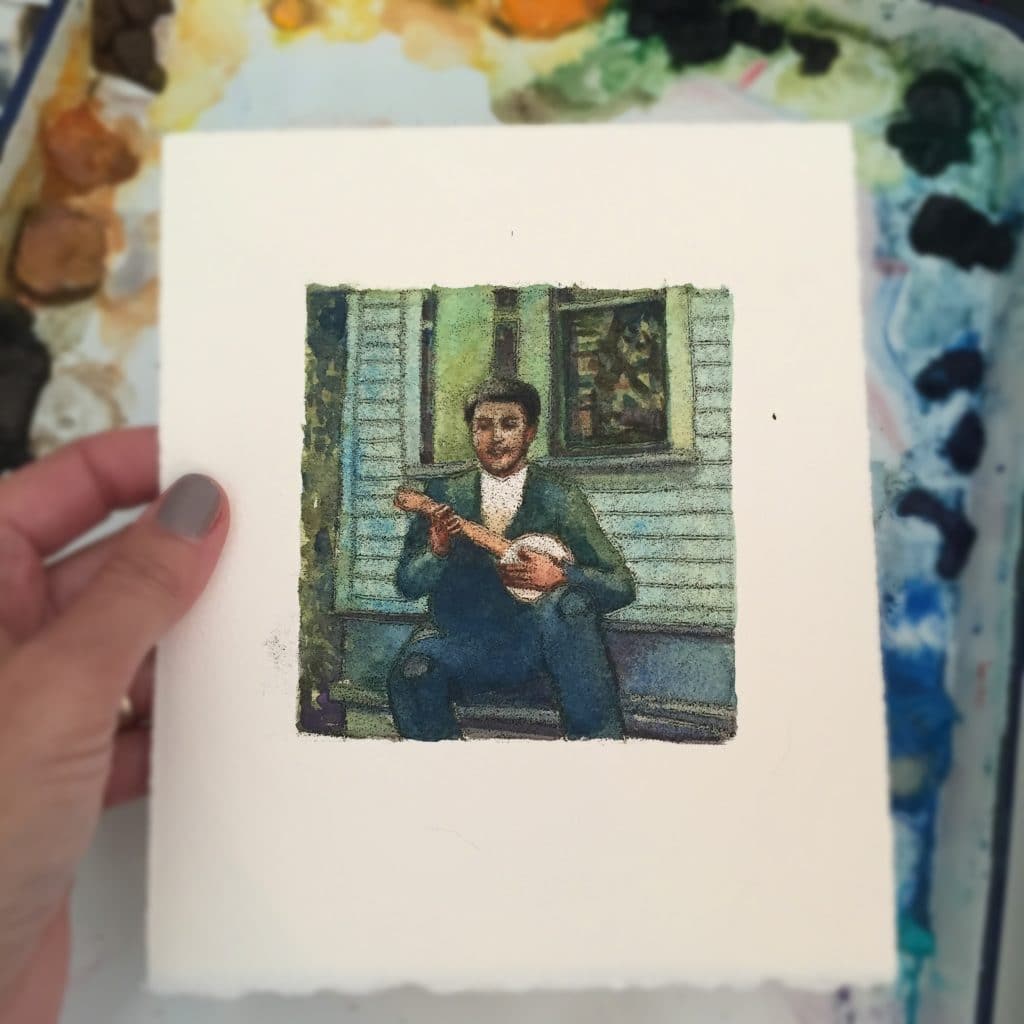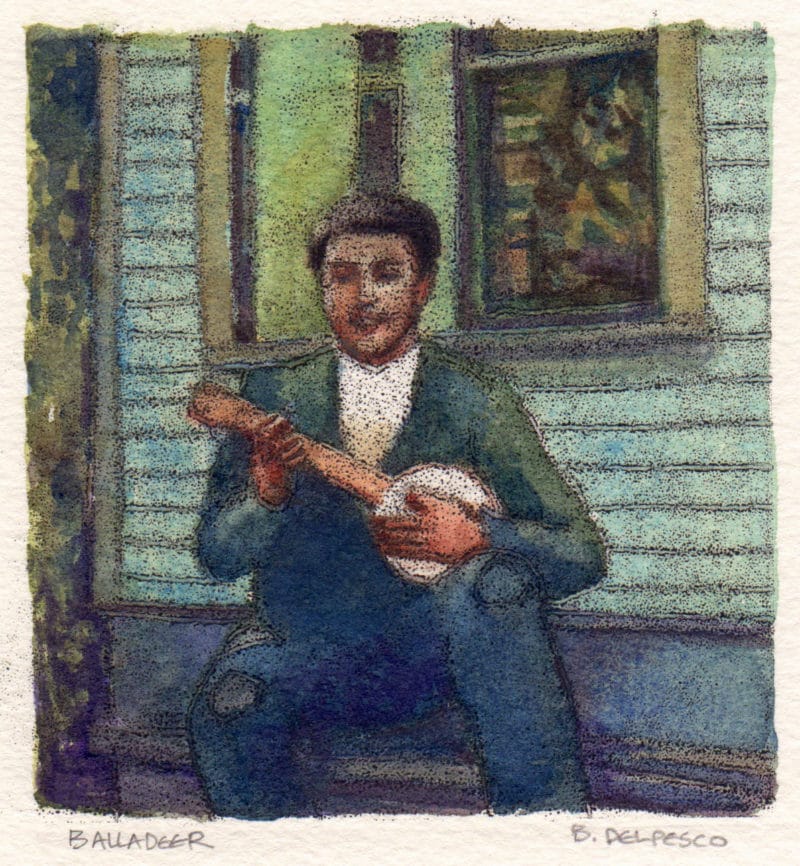
My grandparents met in a Connecticut textile mill as teenagers. They were not yet 20 when they married. He was from Canada and spoke only French, and she was from England, so communication was challenging in their early years. Right up to the end of their lives, they held hands, patted the empty seat next to them beckoning the other to come sit close, and they made each other laugh, especially while reminiscing. I loved visiting them, typing frantically on my lap top, to harvest everything they giggled when I asked “Where were you when you first kissed?” (In the back of a horse-drawn sleigh on a snowy Thanksgiving night in 1934) and “What was your first date like?” (Shared crackers and pickles during a lunch break on the loading dock of the mill) and “Tell me about the first home you shared as newlyweds?” (A single room jutting from the roof of a building at the train tracks, referred to as Our Little Penthouse).

This little monotype was inspired by a photo of my grandfather on my grandmother’s aunt’s porch (she lived with relatives after being orphaned) when they were courting. He and his brother played in a band on the weekends, so he stopped by to woo his crush on the way to a gig. My grandmother said he played so well, and sang so sweetly (in French) that her Aunt would come to the door over and over again to peer at them on the porch, making sure there was no romantic swooning or touching going on. 🙂 They were married for 74 years. Music can be a potent marinade for love. ????

Check the links below for a few of the art supplies I use when working in monotype, or adding watercolor to prints:
rubber gloves http://amzn.to/1bNmWvu
apron http://amzn.to/1fWXkIh
Plexiglass for your table top http://amzn.to/1R7gI7z -or- 12×12 acetate sheets to tape down & roll ink out on http://amzn.to/1UfjNru
akua ink http://amzn.to/1M711w4
4 inch soft rubber brayer http://amzn.to/1vOHPzY
rubber tipped wipe-out tools http://amzn.to/1P08UTR
newsprint for test prints http://amzn.to/1pgAgRb
Arches cover paper (textured surface, great for both dry & wet media on top of monotype prints) http://www.dickblick.com/items/10417-…
Arches 88 paper (very smooth surface – not recommended for wet media, but great for colored pencil or pastel on top of monotype prints) http://amzn.to/1ogZAVT
blending stomps http://amzn.to/1UT3x07
Prismacolor Colored Pencils http://amzn.to/1ogWqS1
Prismacolor blending pencil & sharpener http://amzn.to/1ogWC3L
Watercolor set http://amzn.to/1UXp1c3
Art Eraser http://amzn.to/1UqauH0
Art Masking Tape http://amzn.to/1Sh9jnl
Drawing Bridge http://amzn.to/1pUUvnP
Drawing Board http://amzn.to/1ShiiVx
*Reference Books*
The Painterly Print http://amzn.to/1Ld9aUU
Monotype: Mediums and Methods http://amzn.to/1P0aghm
Printmaking Bible http://amzn.to/1Ld9gvQ
Print Workshop http://amzn.to/1QMmFYl
Monoprinting: Printmaking Handbooks http://amzn.to/2bQ8Spo
If you have any questions about the process, please leave them in the comment section, and I’ll do my best to answer them quickly! Happy art-making!
You can find me here:
https://www.belindadelpesco.com
http://www.patreon.com/bdelpesco
http://www.etsy.com/shop/bdelpesco
http://www.facebook.com/belinda.delpe…
http://instagram.com/bdelpesco
http://www.pinterest.com/bdelpesco/
And then, here’s a fun article from the New York Times featuring museum-goers comments on artwork exhibited in a show titled Unfinished: Thoughts Left Visible at the Met Breuer Museum. When you see work you’ve admired and loved in a museum – especially something you’ve never seen in person before – what goes through your head? What does the art make you feel? Is your reaction ignited exclusively by the success of the process the artist deployed, or the emotive and narrative elements of the image itself?
Thanks ♥ for stopping by,
Belinda
(You can subscribe to get these blog posts via email here.)
A work of art which did not begin in emotion is not art. Emotion is the starting point; the beginning and the end. Craftsmanship and technique are in the middle.
~Paul Cezanne


Your story brought to mind my father’s story of having traveled (hitchhicked) in the US during the Great Depression in his late teens with a fellow musician, playing for room and board. My dad played the banjo, and was also a French Canadian. He just turned 101! I’m listening to the audio version of book you recommended a few blogs ago “The Greater Journey”. All I can say is OMG! It’s pure delight – Can’t thank you enough for putting that one in my radar. I’m sure you are familiar with this artist/printmaker’s work: Charles W. Bartlett – Just received this blog today about his work: http://art-now-and-then.blogspot.ca/2016/09/charles-w-bartlett.html There’s a book about his life listed there and I’m putting it on my reading list.
Hi Gayle! I *knew* we were creative sisters! I’m so glad you’re enjoying The Greater Journey! I loved that book! And yes, I know and love Charles Bartlett’s work… I have the book Printmaker in Paradise, and his block prints of Island life, surfing and travels around the world are incredibly inspiring!
So fortunate that you realized what a treasure your grandparents were before it was too late – the stories you captured help their love live on and enrich your lovely work. Made my day – thank you!
Answering your question, there is nothing like seeing the original painting….The details: light, lines, color….etc…they are so different from a printed page in a book!
Oh Belinda, what a lovely story….
And the monotype is very beautiful! Thanks for the vídeo!
Thank you, Cristiane! 🙂
Great story, Belinda! Thanks so much for sharing.
Thanks for visiting, Carey!
Whenever I see a familiar painting in the Museum, I am bowled over to discover I don’t know the piece at all. It’s not just the interplay of light and color differing from the printed page; it’s the scale. We study art in books, where a painting may be reduced to fit an 8.5×11′ page, or blown up to show detail. That is valuable — but the power of experiencing the actual work in situ is always a revelation.
That includes your work, my artist friend!